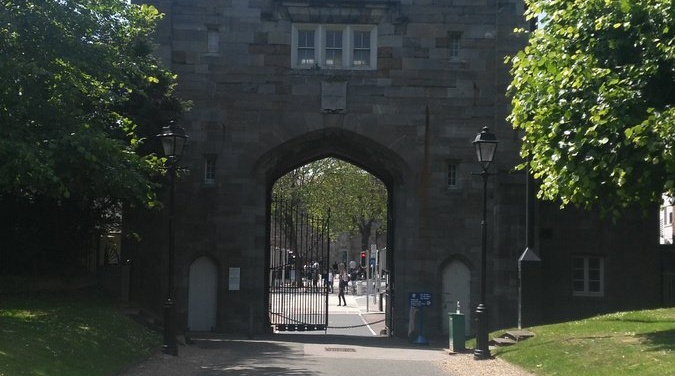

Richmond Tower by Mark Jenkins
One thing for sure is that I’ll never find a fiver or tenner on the ground in Dublin 8! With a wonderful area full of interesting structures and historic locations you’re guaranteed to see me gazing above in wonder and awe on meandering walks about the area. Living where I do in Dublin 8 I’m constantly asked for directions by visitors to the area and I always advise those walking along the Dubline to Kilmainham Gaol to do so via the beautiful surroundings of IMMA.
One structure which I’m very fond of and always stop to admire is Richmond Tower at the western entrance to the Royal Hospital Kilmainham, now the Irish Museum of Modern Art. The imposing form is an apt introduction to the pretty pathway leading by Bully’s Acre and views to the Phoenix Park. Many could be forgiven for thinking that Richmond tower was there all the time but it did have another home before. We’re more used to moving statues like Molly Malone, William Smith O’Brien and Father Mathew!
Richmond tower was previously situated where the termination of the south quays was at the foot of Watling Street just at Rory O’More bridge. The bridge itself was known under various names over the years and in previous forms (Bloody Bridge, Barrack Bridge, Victoria & Albert Bridge, Emancipation Bridge etc…). Erected in 1812, an initiative of Alderman William Darley and designed by Francis Johnston, the gate tower at Watling Street was officially opened by Charles Lennox 4th Duke of Richmond, hence the name. The tower in situ can be seen in an illustration by the brilliant antiquarian and artist George Petrie for the book “Excursions in Ireland” by Thomas Cromwell, and in another contemporary drawing of the area.

It didn’t last relatively long at this location. The opening of the Kingsbridge (Heuston) railway station in 1846 had a huge impact on Dublin 8. The first regular train service began between Dublin and Carlow initially. The barge line at Grand Canal Company reacted by reducing both the price of passenger and parcel fares but rail was the new and more efficient way to travel. The human traffic as a result from the Kingsbridge terminus meant huge congestion on the southern quays so it was resolved to remove the gate. It was decided that the Great Southern Railway Company would foot the bill and that it would be moved and it was noted in the records of the Royal Hospital.
One unexpected discovery was that Francis Johnston had secretly positioned his own family coat of arms above the arch behind a wooden box, painted in the same colour as the tower. The idea was that over time the box would rot away and his own family crest would be revealed. Upon noticing this the governor’s requested that they be removed and replaced with armoreal bearings promised to the hospital by Sir William Betham.

Considering the considerable legacy Francis Johnston left in Dublin with designs such as the GPO and involvement in works like the Chapel Royal, the conversion of the Houses of Parliament and numerous other projects with the Board of Works, it’s a pity they weren’t allowed to remain. It’s just one snippet of so many buildings and sites in the Dublin 8 area with a story to tell.

About the author
Mark Jenkins is a local historian living in the Liberties, and has worked in the James Joyce Library in UCD for the last 20 years.. He has led numerous tours of The Liberties area including Culture Night, Heritage Week and St. Patrick’s Festival among others.
Contact Mark Jenkins
Twitter https://twitter.com/OldeEire
Email markjenkinsis@gmail.com




